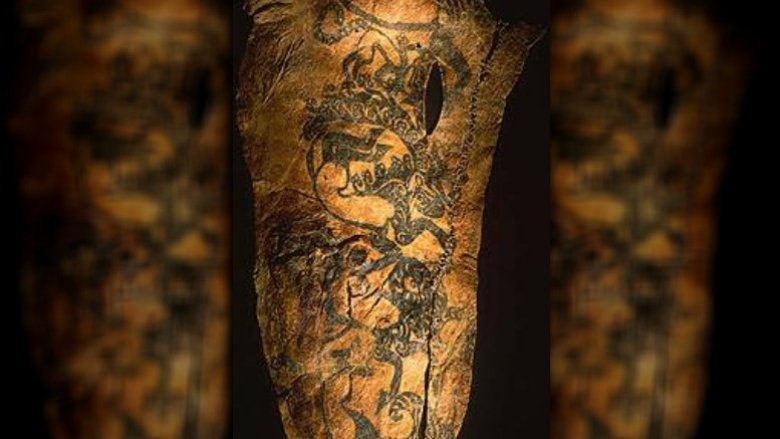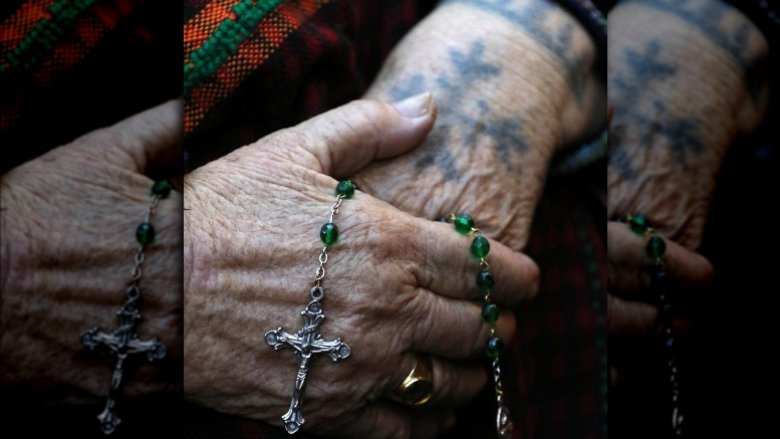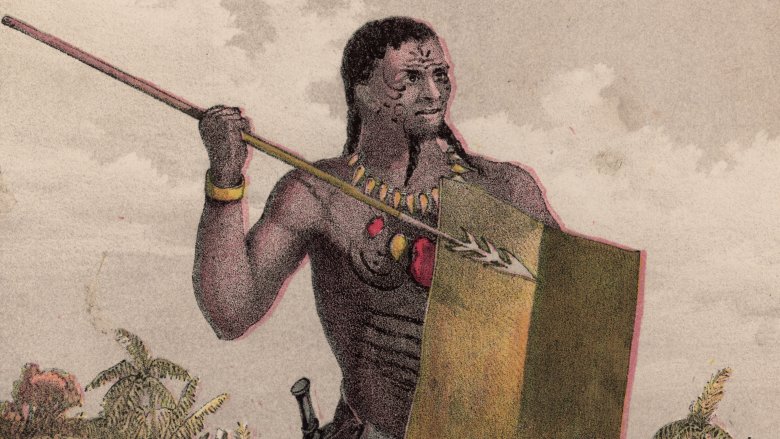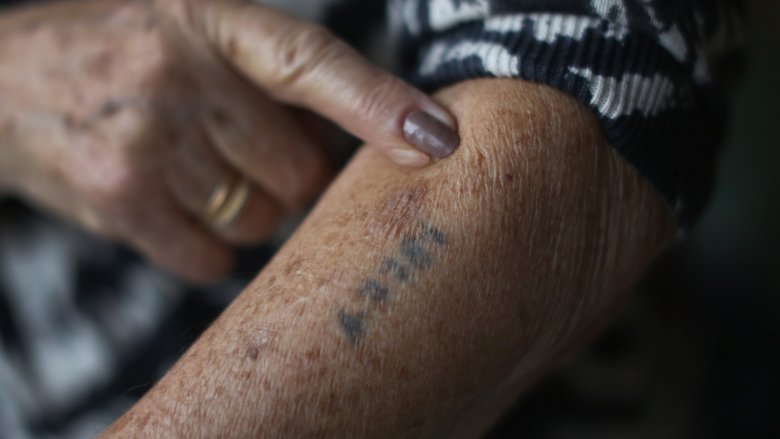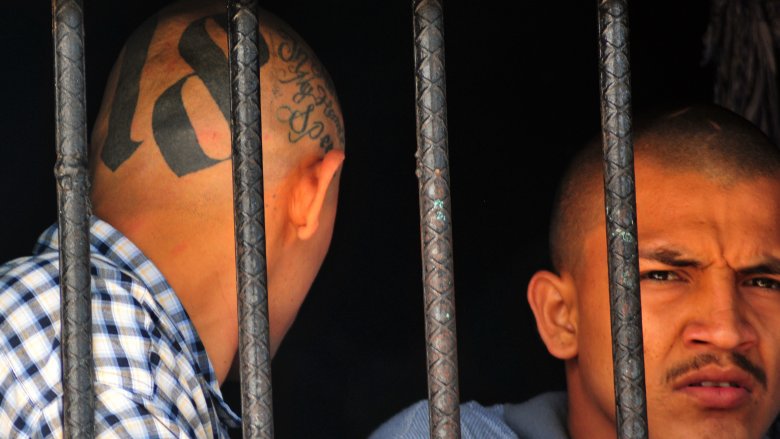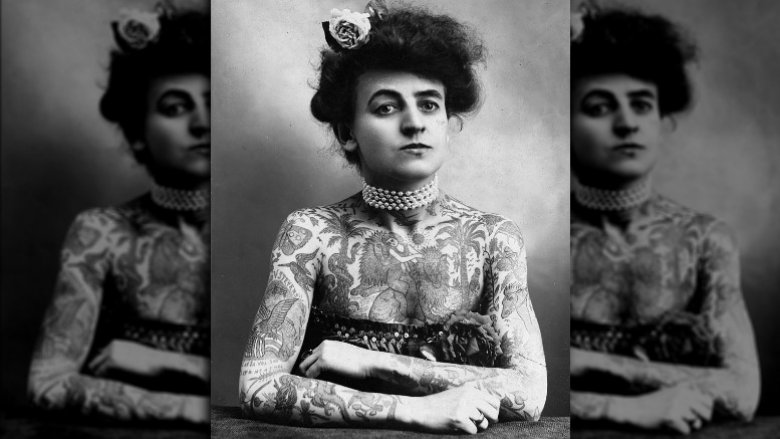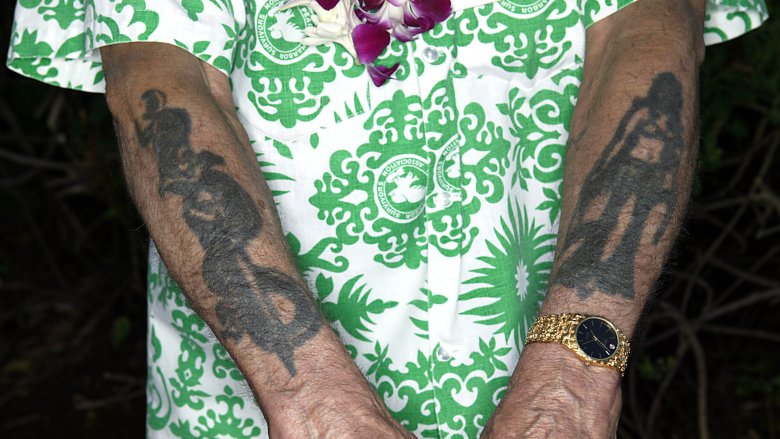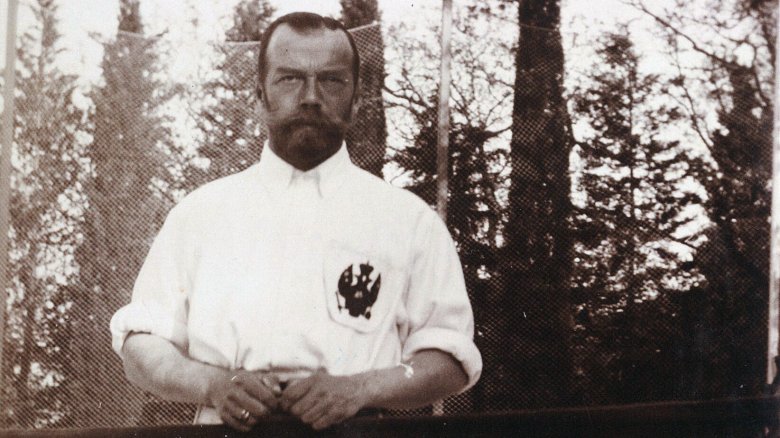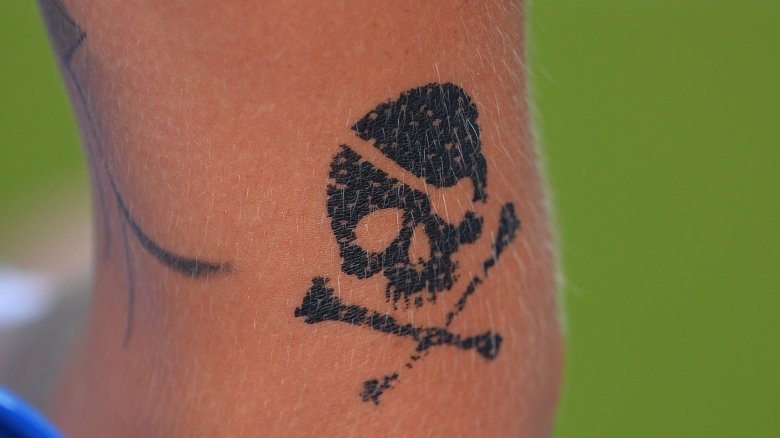The Strange History Of Tattoos
People get tattoos for a lot of reasons. Maybe they want to remember someone who's passed on. Perhaps they love the idea of turning their body into art. Or maybe they got really drunk one night in college, and the stranger next to them at the bar said he was an amateur tattoo artist, and ... look, long story short, it's supposed to be a potato.
But while tattoos are commonplace in this day and age, they have a really weird history, full of violent stories and freaky characters (not to mention famous figures like Kate Moss, who estimates the two swallows on her back are worth "a few million," as they were inked by renowned artist Lucian Freud). Really, the tales of people getting themselves covered in ink are absolutely bizarre. And if you have one, are considering one, or just think they're cool, then read on to find out more about the strange history of tattoos.
Ancient people loved their tattoos
Tens of thousands of years ago, humans started painting cave walls. Then at some point, they thought, "Why not put the art on us?" And that's when tattooing began. Just when this began is unclear, because we keep finding older and older mummies with evidence of ink. But what's certain is that people were getting tatted up a long, long time ago.
But Ötzi, the European Tyrolean Iceman who died around 3250 BC holds the current record for oldest body art, according to Smithsonian Insider. Mr. Ötzi has a whopping 61 tattoos all over his body. For a while, there was an argument that a South American mummy with a pencil mustache tattoo (which is amazing) was older, but then the experts changed their minds. While Ötzi has a lot of tats, they're kind of boring. They're basically just lines and seem to have been meant to be medicinal. They cover parts of his body where he had joint and spinal problems. The BBC reports two 5,000-year-old Egyptian mummies just a shade younger than Ötzi have the first known figurative tattoos, which are horned animals.
We know the Ancient Greeks had tattoos, as did the Ancient Chinese. And importantly, we know ink was for both men and women. Weirdly, for a long time it was thought only ancient women had body art, which is kind of the opposite of what you'd expect. A Siberian princess who died 2,500 years ago has very cool tattoos, described as "phenomenal" and startlingly similar to modern ones.
Tattoos, the Bible, and the Jewish faith
It's commonly known that Jewish people aren't supposed to get tattoos, but the reason is less than cut and dried. One of the many laws in Leviticus says, "You shall not make gashes in your flesh for the dead, or incise any marks on yourselves." That's a translation from the Hebrew, obviously, but you'll notice it's kind of a weird way to describe tattooing, and its meaning is open to interpretation. Harvard Divinity School explains that there probably wasn't any real issue with tattooing, and Jews might've been doing it before the ban, but by making them a no-no, Israelites were marking themselves (by not marking themselves) as different from people like the Babylonians and Egyptians, who did tattoo themselves. Inkless skin was another way the early Jews became their own group.
Then the Nazis added a whole other horrible level to Jewish tattooing. In concentration camps, the Nazis forcibly inked identification numbers on their prisoners, which was a violation of their bodily autonomy and their religion. So now, Jews getting tattoos is extra controversial.
That doesn't mean they don't do it, though. According to Alma, many young Jews get tattoos, including ones directly related to their religion. And in a dark but meaningful way of remembering what their relatives went through, some even get the numbers from concentration camps. However, there aren't any real consequences to getting tattoos if you're Jewish, as the belief you can't be buried in a Jewish cemetery if you have body art is false.
Christians embraced religious tattoos
Even though Leviticus is included the Christian Bible, the verse about not getting tattoos was pretty much ignored, just like similar Jewish laws on eating kosher. According to the Catholic News Agency, that particular branch of Christianity has never had a ban on body art. Sometimes people bring up a supposed rule against them brought in by Pope Adrian I in the 700s, but there's absolutely no evidence for this. Some later Christian churches weren't the biggest tattoo fans (usually the ones that don't like other fun stuff like alcohol; Mormonism strongly discourages them, for example), but there has never been a Christianity-wide ban.
Quite the opposite is true, in fact. In the Roman Empire, before Christianity was legal, early believers would often tattoo themselves with signs of their faith, marking themselves permanently as followers of Christ and, ironically, criminals. In the Bible, Paul says he "bears the marks of Jesus" on his body, and while scholars think he was being metaphorical, it isn't certain.
Christians kept up the body art even once their religion was widely accepted. Early historians talk about the practice, and popular design choices seem to have been crosses and marks representing the wounds of Jesus. In 787, a church council determined that Christians with tattoos were to be "greatly praised," but only if the art was religious in nature. And for the past 700 years, it's been a tradition for Christians who visit the Holy Land to get a tattoo to commemorate the experience.
Tribal tattooing has a rich history
People outside Europe and the Middle East have been tattooing for thousands of years. Tribal ink has been an important part of societies from Polynesia to North America. According to PBS, in Samoa, men would be tattooed from their midriff to their knees. This involved days-long sessions with a mallet and an ink-laden comb. The pain was crazy, and there was a very real risk of death from infection, but any man who couldn't hack it and had an unfinished tat for the rest of his life was shamed. Women also got tattoos, although theirs tended to be a bit smaller.
Indians.org says Native Americans used a sharpened bone or rock to carve a design into the skin. The open wound was then rubbed with soot or dye, which would leave a stain. Men might get a tattoo to represent a particular victory or for spiritual reasons. Some tribes believed tattoos could give them supernatural powers, and members got an image of an animal they wanted to be like. Different tribes could be identified by different designs. Sometimes women got them, as well.
Of course, then Christians came along and decided since "savages" were tattooing, it must be stopped. Western missionaries who showed up in Polynesia in the 1800s "vilified tattooing as unholy," and the art form went into decline.
Forced tattooing was always inhumane
The Nazis were far from the first jerks to tattoo people against their will. Forced tattooing has been around pretty much as long as voluntary tattooing. The Journal of the American Oriental Society says in China, tattoos were "considered a highly effective means of punishment" for "most of recorded history." If you broke the law, ink marked you out as a criminal for life and brought shame on you and your family. At some point, soldiers were also forcibly tattooed so they wouldn't be able to desert, but this practice was highly controversial. That doesn't mean it stopped. Even in the 1800s, the British army tattooed deserters with a "D" or "BC" (for "bad character.")
According to The Historical Encyclopedia of World Slavery, slaves have also been forcibly tattooed for millennia. They were inked so they couldn't run away and to mark them as less than dirt. The Ancient Persians, Greeks, Romans, Chinese, and Japanese all tattooed slaves. This was why Christians in Ancient Rome would sometimes tattoo themselves voluntarily, preemptively marking themselves as criminals and the slaves they would become if their religion was found out.
The practice of forced tattooing continues, shockingly, to this day. In 1993, Indian police inked "jeb katri" (Punjabi for "pickpocket") on the foreheads of four women who were habitual offenders. This caused a huge scandal, and the cops received jail time. And in 2017, CNN reported trafficked women were being marked with tattoos meant to identify them as property.
Criminals and tattoos are still synonymous
In the past, criminals were inked against their will, but these days, the association between law breakers and ink is just as strong, even if we don't do it as punishment anymore. People tend to think of the tattooed, especially the heavily tattooed, as bad guys. This is so ingrained that it actually affects the outcome of trials. According to the Orlando Sentinel, even though everyone from celebrities to soccer moms have tattoos these days, there's still a criminal association for some people, and sometimes those people end up on juries. So defense attorneys advise their tattooed clients to cover up body art with clothing or, in extreme cases, even makeup. A judge once ordered the state to pay for a professional cosmetologist to cover the swastika and barbed wire tats of a man on trial for murder.
Once you end up in jail though, tattoos become "a virtual rite of passage," reports Prison Legal News. The amateur ink that criminals get behind bars is usually filled with meaning, whether it indicates their time inside, the crimes they committed (like the infamous teardrop for murderers), or the prison gang they belong to. Both women and men get them, and a lot of them realize they need them removed once they reenter society.
But do tattoos and bad behavior actually have a correlation? A 2010 study out of Texas Tech University was widely reported as finding that the more tattoos you had, the more likely you were to be "deviant," but that's not actually what it said. Instead, according to the study, since so many people have tattoos these days, the correlation with deviant behavior is extremely low. The four percent of tattooed subjects who did get a bit naughty tended to have four or more tattoos and at least seven piercings. But just being tattooed doesn't mean you're any more likely to be a criminal.
The history of tattooed 'freaks'
In the 1800s, tattoos were modernized a bit and became more common. Even society women got tattoos. That meant if you wanted to stand out, you had to get lots of ink. Since this was also the heyday of the circus and its sideshows, this meant the introduction of the heavily tattooed "freak." While some sideshows had tattooed men, it was the tattooed lady that really made headlines.
According to Vice, the first "official" tattooed lady was Nora Hildebrandt who worked briefly for Barnum & Bailey before she was replaced by someone hotter. Tattoos and female sexuality were heavily intertwined. Time says tattooed ladies often performed stripteases to show off all their ink. In the beginning of the phenomenon, the women all had stories about how they'd been kidnapped and tattooed against their wills, but this lie fell out of fashion. Spectators could buy photos of tattooed ladies to take home as souvenirs. While there was definitely an exploitative side, working as a sideshow attraction was one of the few ways women at the time could earn their own money and have some kind of independence.
These days, lots of tattoos can still get a woman noticed, but the ante has seriously been upped. The most tattooed woman in the world as of 2018 was a 69-year-old from Florida (of course) named Charlotte Guttenberg, with 98.75 percent of her body covered in ink. But she was beaten out by a man named Lucky Diamond Rich, whose entire body is tattooed.
Sailors have their own particular tattoo culture
In most people's minds, sailors and tattoos go together like, well, sailors and the ocean. There's good reason for this. The history of the nautical tattoo stretches back at least to the 1500s, according to TatRing. While Christian missionaries might've seen Polynesian tattooing as something to be stamped out, Western sailors thought it was a great idea to steal. Naval History and Heritage Command says this was exacerbated by the length and boring nature of sea voyages. Sailors sat around with nothing to do, so they took up tattooing each other to pass the time. It was a very amateurish affair. Ink was made from gunpowder and urine. The Brits started the tradition, and it spread to America, until by the late 1700s, one-third and one-fifth of their navies, respectively, had body art.
During the Civil War, sailors got tattoos to commemorate the first battle between ironclad ships. Participants in the Spanish-American War inked "Remember the Maine" on their bodies. Patriotic designs have always been popular, along with military insignia or the names of loved ones. Then, of course, there were the naked ladies, although during World War I, these were considered unacceptable, and many sailors' provocative ink women suddenly got clothing added on top. Some tattoos have meaning of talisman-like powers. For example, an anchor means you've crossed the Atlantic, while a pig and a rooster tattooed on each foot is, bizarrely, supposed to save you from drowning in a shipwreck.
Even fancy people got tattoos
We might think of tattoos as something purely for lowlifes up until very recently, but tattoos came into fashion in a big way in the 1800s. It wasn't just sailors and sideshow freaks who found themselves covered in ink, either. For a period, rich men and women, even royalty, absolutely had to have body art.
According to The Vanishing Tattoo, the royal seal of approval came in 1862, when the Prince of Wales (the future Edward VII) visited Jerusalem and, like so many pilgrims before him, got a tattoo to commemorate the trip. In 1882, his sons the Duke of Clarence and the Duke of York (the future George V) got tattoos in both Japan and the Holy Land. None of these were tiny things, either, but large works of art. Town & Country says Russia's Nicholas II, George V's cousin, got his own dragon tattoo in Japan in 1891. (That's him pictured, with the tattoo on his right arm. It's there, promise.)
Suddenly, other wealthy people wanted tattoos, as well. Aristocrats and just standard rich men and women in the UK and America jumped on the body art bandwagon. The stories are a bit hard to believe. One newspaper reported at the end of the 1800s that three-quarters of fashionable women in New York City had ink. There was a widely reported story that Winston Churchill's mom got a snake tattoo, but if she did, there's no photographic evidence. Even today, some royals, such as Lady Amelia Windsor, have ink.
The Tattoo Renaissance
As popular as tattoos have been for different types of people at different times in history, there's perhaps never been a period for body art like the one we're living in now. That's because in the late 1950s, we entered what became known as the Tattoo Renaissance. Tattoo artists really earned the artist part of their name, and people like Lyle Tuttle, Cliff Raven, Don Nolan, Zeke Owens, Spider Webb, and Ed Hardy completely changed the tattoo landscape. Yes, Ed Hardy, who these days is a punchline because tacky frat bros wear his eponymous clothing line, was a real guy who was really talented, and tattooing wouldn't be what it is without his contributions. (He's pictured on the right at the Second World Tattoo Convention in 1977.) It was obvious even at the time that things were changing in a big way, and Time covered the Tattoo Renaissance back in 1970, saying body art was the "vogue of the counterculture."
Hippies definitely had a big part in the ink boom, as did other marginalized groups. The Tattoo Renaissance: an Ethnographic Account of Symbolic Consumer Behavior reports that LGBTQ people, feminists, and environmentalists all gravitated to tattoos in order to "fortify identity" and "reassure the ego." In other words, tattoos are personal and say something about you to others. Women especially started getting into ink in much greater numbers through the decades, until today when it's not weird for a lady to have a tattoo at all. The Tattoo Renaissance is still going strong.
They're still dangerous
Tattoos are arguably more common and safer than ever before. Parlors are heavily regulated, and many are basically as clean as hospitals. But getting a tattoo can still cause problems, from the slightly annoying to the deadly.
Despite a 2010 survey that found 40 percent of 18- to 29-year-olds had at least one tattoo (via The Houston Chronicle), in the US, the law consistently rules you can be fired for your ink. Employers can also force you to cover it up. And that's just the beginning. CBS News reported on a 2015 study that found ten percent of tattoo-getting in New York City had "short-term complications." Six percent of people suffered "significant problems" including rashes, itching, or swelling that stuck around for more than four months. Some people had these tattoo-related problems for years. It was so bad that the researcher admitted being surprised by her findings.
The best case scenario when you have a bad tattoo reaction (it's usually an allergy to the ink) is taking steroids. However, in some cases, it might be better to get the tattoo lasered off. There are occasionally reports (usually in tabloids) about serious scarring or even amputation close calls. Sometimes there are outbreaks of bacteria in ink and sharing needles can spread diseases as well (but no good parlor would do that). Aftercare is just as important. According to Paste, in 2017, a Texas man died when he swam in the Gulf of Mexico just five days after getting a calf tattoo. The open wound got infected and killed him.

